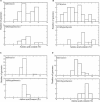Entropic stabilization of proteins and its proteomic consequences
- PMID: 16201009
- PMCID: PMC1239905
- DOI: 10.1371/journal.pcbi.0010047
Entropic stabilization of proteins and its proteomic consequences
Abstract
Evolutionary traces of thermophilic adaptation are manifest, on the whole-genome level, in compositional biases toward certain types of amino acids. However, it is sometimes difficult to discern their causes without a clear understanding of underlying physical mechanisms of thermal stabilization of proteins. For example, it is well-known that hyperthermophiles feature a greater proportion of charged residues, but, surprisingly, the excess of positively charged residues is almost entirely due to lysines but not arginines in the majority of hyperthermophilic genomes. All-atom simulations show that lysines have a much greater number of accessible rotamers than arginines of similar degree of burial in folded states of proteins. This finding suggests that lysines would preferentially entropically stabilize the native state. Indeed, we show in computational experiments that arginine-to-lysine amino acid substitutions result in noticeable stabilization of proteins. We then hypothesize that if evolution uses this physical mechanism as a complement to electrostatic stabilization in its strategies of thermophilic adaptation, then hyperthermostable organisms would have much greater content of lysines in their proteomes than comparably sized and similarly charged arginines. Consistent with that, high-throughput comparative analysis of complete proteomes shows extremely strong bias toward arginine-to-lysine replacement in hyperthermophilic organisms and overall much greater content of lysines than arginines in hyperthermophiles. This finding cannot be explained by genomic GC compositional biases or by the universal trend of amino acid gain and loss in protein evolution. We discovered here a novel entropic mechanism of protein thermostability due to residual dynamics of rotamer isomerization in native state and demonstrated its immediate proteomic implications. Our study provides an example of how analysis of a fundamental physical mechanism of thermostability helps to resolve a puzzle in comparative genomics as to why amino acid compositions of hyperthermophilic proteomes are significantly biased toward lysines but not similarly charged arginines.
Conflict of interest statement
Figures






Similar articles
-
[A comparative study of phenylalanyl-tRNA synthetases from Escherichia coli and Thermus thermophilus by the tritium topography method].Biokhimiia. 1990 Sep;55(9):1570-7. Biokhimiia. 1990. PMID: 2078635 Russian.
-
Protein surface amino acid compositions distinctively differ between thermophilic and mesophilic bacteria.J Mol Biol. 2001 Jun 15;309(4):835-43. doi: 10.1006/jmbi.2001.4718. J Mol Biol. 2001. PMID: 11399062
-
The computational detection of functional nucleotide sequence motifs in the coding regions of organisms.Exp Biol Med (Maywood). 2008 Jun;233(6):665-73. doi: 10.3181/0704-MR-97. Epub 2008 Apr 11. Exp Biol Med (Maywood). 2008. PMID: 18408149 Review.
-
Extremely thermophilic translation system in the common ancestor commonote: ancestral mutants of Glycyl-tRNA synthetase from the extreme thermophile Thermus thermophilus.J Mol Biol. 2007 Jun 15;369(4):1060-9. doi: 10.1016/j.jmb.2007.04.001. Epub 2007 Apr 5. J Mol Biol. 2007. PMID: 17477933
-
Functional genomics and proteomics in the clinical neurosciences: data mining and bioinformatics.Prog Brain Res. 2006;158:83-108. doi: 10.1016/S0079-6123(06)58004-5. Prog Brain Res. 2006. PMID: 17027692 Review.
Cited by
-
A role for A-to-I RNA editing in temperature adaptation.Physiology (Bethesda). 2012 Dec;27(6):362-9. doi: 10.1152/physiol.00029.2012. Physiology (Bethesda). 2012. PMID: 23223630 Free PMC article. Review.
-
Nonspecific yet decisive: Ubiquitination can affect the native-state dynamics of the modified protein.Protein Sci. 2015 Oct;24(10):1580-92. doi: 10.1002/pro.2688. Epub 2015 Jun 9. Protein Sci. 2015. PMID: 25970168 Free PMC article.
-
Proteome adaptation to high temperatures in the ectothermic hydrothermal vent Pompeii worm.PLoS One. 2012;7(2):e31150. doi: 10.1371/journal.pone.0031150. Epub 2012 Feb 10. PLoS One. 2012. PMID: 22348046 Free PMC article.
-
Thermostabilization mechanisms in thermophilic versus mesophilic three-helix bundle proteins.J Comput Chem. 2022 Jan 30;43(3):197-205. doi: 10.1002/jcc.26782. Epub 2021 Nov 5. J Comput Chem. 2022. PMID: 34738662 Free PMC article.
-
Organization of the multiaminoacyl-tRNA synthetase complex and the cotranslational protein folding.Protein Sci. 2015 Sep;24(9):1475-85. doi: 10.1002/pro.2735. Epub 2015 Jul 14. Protein Sci. 2015. PMID: 26131561 Free PMC article.
References
-
- Pokala N, Handel TM. Review: Protein design—Where we were, where we are, where we're going. J Struct Biol. 2001;134:269–281. - PubMed
-
- Malakauskas SM, Mayo SL. Design, structure and stability of a hyperthermophilic protein variant. Nat Struct Biol. 1998;5:470–475. - PubMed
-
- Dominy BN, Perl D, Schmid FX, Brooks CL., 3rd The effects of ionic strength on protein stability: The cold shock protein family. J Mol Biol. 2002;319:541–554. - PubMed
-
- Dominy BN, Minoux H, Brooks CL., 3rd An electrostatic basis for the stability of thermophilic proteins. Proteins. 2004;57:128–141. - PubMed
-
- Sanchez-Ruiz JM, Makhatadze GI. To charge or not to charge? Trends Biotechnol. 2001;19:132–135. - PubMed
Publication types
MeSH terms
Substances
LinkOut - more resources
Full Text Sources
Other Literature Sources
Miscellaneous

